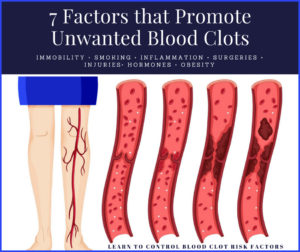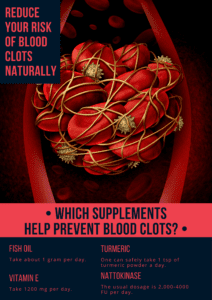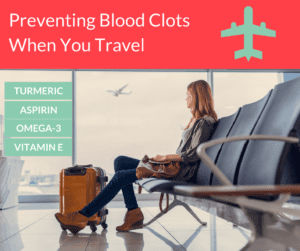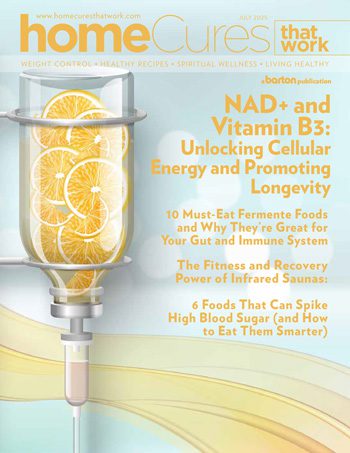Tips for Blood Clot Prevention
Reduce Your Risk Of Blood Clots Without A Prescription
Lacey loved to travel. Now in their retirement, she and her husband decided to take some trips. Their first trip was to Italy, but when she got there she was having trouble. One leg was swelling up, and cramping, it turned red, and hurt when she walked. She went to a doctor and found out that she had a blood clot in her leg, also known as DVT. She had to cut her trip short, start on blood thinners, and come home for treatment to prevent clots from getting into her lungs – which is potentially deadly.
Isn’t the body filled with blood?
We often think of the body as filled with blood, but all the blood must stay in the blood vessels. Outside of the blood vessels, blood does damage – like bruising. So, if your blood doesn’t clot, it will leak out every time there is a broken blood vessel. This happens a lot, even if it not visible to the naked eye!
For example, most rat poisons are just blood thinners. When the rat breaks a blood vessel it doesn’t clot and the rat dies of internal bleeding. People can develop the same problem, such as in hemophilia, if their blood doesn’t clot. The blood must clot – but not too much.
What happens if the blood clots easily?
There is a delicate balance between clotting off every broken blood vessel and shutting down blood vessels by over-clotting. If blood clots start forming in the veins where slow moving blood pools together, then impaired circulation can lead to swelling, pain, cramps, and other problems.
An analogy to this process is a slow moving river. Over time, weeds and algae start to accumulate along the banks of the river where slow water flows. Gradually, as the weeds multiply, they begin to invade the center of the river because they can withstand the pressure of the oncoming water flow. Likewise, a blood clot can form at the site of that rupture and can completely or partially obstruct the blood flow at that point.
The greatest risk of blood clots is DVT, or Deep Vein Thrombosis. Clots in the small veins under the skin can cause pain and swelling. But deep veins, the ones that run between the muscles deep in the thigh, can get clots that are deadly. If these blood clots in the deep veins of your muscles break off and travel up to the lungs, they can plug up a large portion of the circulation and cause death. This is known as a pulmonary embolism, or PE.
Why do blood clots form in the veins?
When we get cut, the body creates an inflammatory response:
- Immune cells arrive to protect against infection
- Repair cells arrive to initiate repair
- Blood plasma brings protein “clotting factors“
- Platelets initiate a cascade of reactions to form blood clots and stop the bleeding
But there are several reasons why blood clots might happen when there isn’t any bleeding:
- Genetic factors
- Inflammatory conditions
- Infectious diseases
- Damaged blood vessels
- Pooling of blood, or poor circulation
What are the genetic reasons for clotting?
Some people have a genetic disposition to blood clots because their body doesn’t make the proper proteins that form or create clots. Inherited (genetic) disposition to form clots in the veins is common. Genetic disposition to clotting is mostly found in Caucasian people, and this condition is dominant. This means if one of your parents has it, you have a 50% chance of getting it. The significant types include:[1]
- Factor V Leiden – affects 7% of Caucasian people
- Factor II Prothrombin – affects 3%
- Protein C deficiency – Less than 1%
- Protein S deficiency – Less than 1%
- Antithrombin III deficiency – Less than 1%
However, even if you have the gene, it doesn’t mean that you will get clots. More than 90% of people with Factor V Leiden, for example, never get blood clots or have clotting problems.
7 Factors that Promote Unwanted Blood Clots
If the genes aren’t the cause, what is? Our story of Lacey, above, illustrates several issues that cause most blood clots. All the real risk factors for blood clots are controllable, being lifestyle issues.Let’s discuss each one.
1. Immobility
Lacey had been on an airplane for twelve hours on the way to Italy. She got up to go to the bathroom a couple of times, but otherwise was immobile. The veins need motion to pump the blood back up to the heart; there is no heart in the feet to pump the blood. The muscles massage the veins, pushing blood up through them, and the movement of the body keeps the blood flowing. Long plane rides pose a bigger risk for blood clotting than genes. One study showed that flying only 4 hours increased the risk of DVT by 3 times.[2] Another systematic review indicated about 1% of people who fly more than 6 hours get thrombosis. However, less than half have any symptoms.
This does not only apply to airplanes. Any time a person is confined in a small space, the blood can slow down, allowing clots to form. Even when you’re stuck at your desk for a long period of time, blood can pool in your legs, paving the way for a clot. If you have to sit for several hours — especially for longer than six hours — make sure you get up and move around as much as possible. While seated, raise and lower your heels and toes, to encourage circulation. Don’t forget to drink plenty of fluids.
Besides long trips, people who don’t exercise have an increased risk of clotting. Limb immobility increases the risk of blood clots because it slows the blood’s circulation, increasing the likelihood it will pool. A static pool of blood offers an ideal environment for clot formation.
2. Smoking
Those who smoke increase their chances of blood clots because smoking damages the lining of the blood vessels. Remember, when there is any tissue damage, the body makes proteins that cause clotting to prevent excessive bleeding. Damage to blood vessels in any way will increase clotting.
3. Inflammation
Any form of inflammation increases the tendency to form clots. Inflammation is damage to tissues in any way. It can be caused by:
- Allergic reactions to the environment, including foods
- Infections such as viruses or bacteria
- Toxins such as homocysteine
- Deficiencies such as omega-3 oils
- Autoimmune diseases such as arthritis or [3]
4. Surgery
Remember that the factors for clotting are activated anytime there is damage to tissues. Surgery creates a lot of damage, and thus a lot of clotting factors. Those who are disposed to getting clots are much more likely to have DVT and PE following a surgery such as knee or hip replacement because these cause immobility – adding another blood clotting risk factor![4]
5. Injuries
One young man I saw was hit in the leg with a large rock while working on a construction site. He thought the pain would go away, but when his ankle started swelling, he came in. The ultrasound showed a clot in his veins. He had to be on blood thinners for three months until the clot completely dissolved. Major trauma that can cause internal bleeding also activates clotting factors. This is essential to prevent death from internal bleeding; however, it may also form clots in the veins.
6. Hormones
Lacey and her husband were both on the plane, but only she got a blood clot. Women are more likely to form clots. Even young women on birth control pills have a significant increased risk of DVT. Pregnant women have double the risk for blood clots because they have both sluggish circulation from the uterus pressing against the veins, and increased hormones, namely estrogen.[5]
7. Obesity
There are several factors that increase clotting in people who are overweight. Sluggish circulation is part of the problem, especially if one is sedentary. Another issue is inflammation because excess calories leads to increased inflammatory reactions.[6] A third is related to leptin production, which excels when more fat is produced. “Blood clotting begins from an interaction between leptin and the leptin-receptor that is on platelets.”[7]
6 Ways to Reduce Your Risk of Blood Clots Naturally
DVT and PE are very dangerous, even life-threatening, but not very common. Most often, there is more than one risk factor involved before people get these. Awareness and prevention are key ways to determine your risk, and prevent blood clotting.
- Test your genes – every doctor can do the simple tests for Factor V Leiden and Prothromin, if you have any family history or personal history of clotting.
- Stop smoking – this is a no-brainer.
- Lose weight – this will improve circulation and reduce leptin in your system.
- Fast – one of the best ways to eliminate toxins and reduce inflammation in the body.
- Exercise – this doesn’t require body-building, just use your muscles daily.
- Avoid hormones (birth control) if you have another risk factor such as obesity, smoking, or genetic. Otherwise, if you get hormone replacement, use bioidentical hormones, not birth control pills.
Which Supplements Help Prevent Blood Clots?
- Fish oil – Omega-3 fatty acids affect blood clotting by decreasing platelet aggregation, which modestly prolongs bleeding time. Take about 1 gram per day.
- Vitamin E – Vitamin E has antiplatelet and possibly also anticoagulant properties. Take 1200 mg per day.
- Turmeric is a great herb for lowering inflammation and decreasing clotting. One can safely take 1 tsp of turmeric powder a day. Two of the best ways to take turmeric powder are – Turmeric milk and Golden paste. Turmeric is poorly absorbed by the body and thus is best taken along with fats and black pepper.
- Nattokinase is an enzyme that dissolves clots for those who have clotting problems, or have other risk factors. I wouldn’t use it for prevention unless you have some risks. The usual dosage is 2,000-4000 FU per day.
Diet Tips to Prevent DVT
Generally eating fresh, organic, raw vegetables, and avoiding processed foods will diminish your risk of inflammation, arthritis, and blood clots. There are some other ingredients found in nature that can help reduce the risk of blood clotting:
- Garlic – is probably the best of all foods that prevent blood clots from forming.
- Fish – has omega 3 fats. Omega-3 fatty acids act as a natural anticoagulant by altering the ability of platelets in the blood to clump together.
- Curry decreases inflammation and the main curative ingredient, curcumin, works on platelets to prevent blood clots from forming.
- Drink water to keep hydrated. Staying hydrated is said to help boost circulation while flushing out toxins that could cause clots. Drink about 1 quart per day for most people, increase if you exercise to sweat or live in a very dry climate.
- Kale and other greens keep clotting factors at normal levels.
What if I’m going to travel?
If you have ever had clots in your veins, don’t wait until there are symptoms to start prevention. The simple things make a big difference.- If you are traveling, take a dose of turmeric (curcumin) before you go.
- Most doctors are recommending an aspirin before travel.
- Omega-3 oils and a dose of vitamin E will also be helpful.
- Also, be sure to exercise in your seat during the trip. Set an alarm to stretch your legs and move around every hour. The key to safe travel is to move around, especially your feet.
We can prevent blood clots when we know why they happen. However, the simple measures we discussed to prevent clots are great for general health anyway: eat good food, exercise regularly, decrease inflammation, decrease weight, stop smoking, and take some supplements to lower inflammation. Think about it! This isn’t rocket science! Generally keeping your body healthy will prevent most of the problems of blood clots, DVT, and PE.
P.S. Two years later, Lacey still gets swelling in that leg, even though an ultrasound showed no more clots. This is because the valves in her veins were damaged.
Prevention is much better than treatment.
Need a reminder about how to take care of your blood pressure? Check out our natural home remedies for blood pressure. And if flying makes you anxious, there are plenty of herbal relaxation methods to trust. Don’t forget to stay active while flying, before and after your trip. Just walking around and cure many health problems.



























